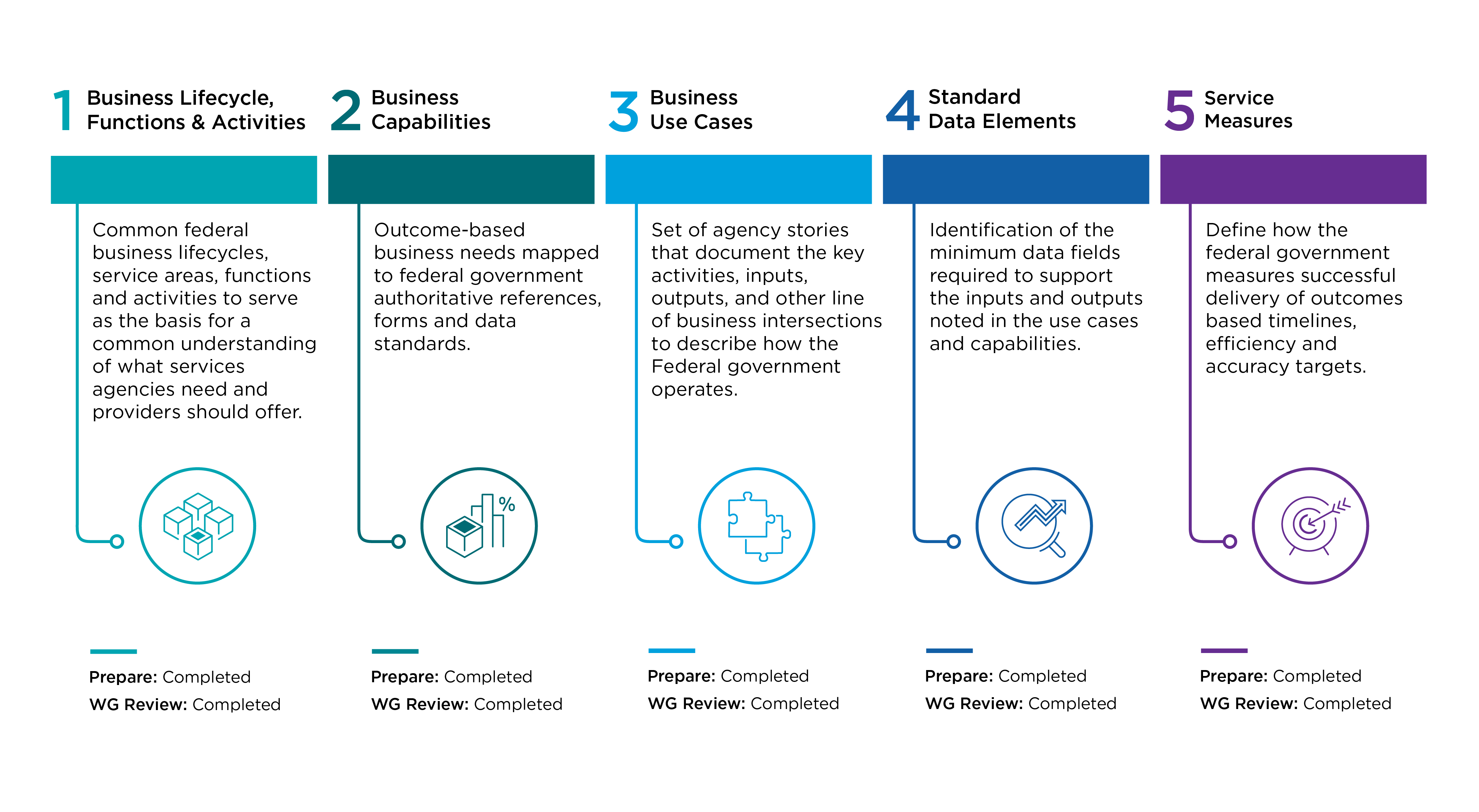ICAM Federal Integrated Business Framework (ICAM FIBF)
The Identity Credentialing and Access Management (ICAM) Subcommittee through its Federal Integrated Business Framework (FIBF) Working Group is establishing ICAM as a federal function that will support and enable practically every mission support area. This will affect not only ICAM programs, but also areas such as Financial Management, Cybersecurity, Electronic Records Management and Human Resource Management, etc.
All five ICAM FIBF components are drafted and establish the ICAM baseline for interoperable business and data standards.
Project Timeline
The project timeline is as follows:
Please download DRAFT ICAM FIBF Components 4 & 5 below to review:
- DRAFT ICAM FIBF Components 4 & 5
- Component 4, Standard Data Elements
- Component 5, Service Measures
Please submit your feedback once your review is complete. The comment period will end September 30, 2024.
ICAM FIBF Background
Since the inception of Homeland Security Presidential Directive 12 (HSPD-12) and OMB M-05-24, it has been a policy goal to establish common ICAM business standards. The FICAM community collectively recognized this goal as a top priority through survey results recently conducted by the ICAM Subcommittee.
As described in Office of Management and Budget (OMB) M-19-16, the Office of Shared Solutions and Performance Improvement (OSSPI) helps agencies identify and gain agreement on common governmentwide capabilities for shared services using the FIBF; thereby making it a natural fit for the ICAMSC to collaborate with OSSPI and leverage the FIBF for the development of common ICAM business standards.
What is FIBF?
FIBF is generally accepted in the Federal Government as a tool for documenting common business requirements; it is currently being used by 13 other Federal Functional Areas including Financial Management, IT Services, and Cybersecurity.
-
Component #1 - Business Lifecycles
Federal Business Lifecycles, functional areas, functions, and activities serve as the basis for a common understanding of what services agencies need and solutions that should be offered. -
Component #2 - Business Capabilities
Business Capabilities are the outcome-based business needs mapped to Federal government authoritative references, forms, inputs, outputs, and data standards. -
Component #3 - Business Use Cases
Business Use Cases are a set of agency “stories” that document the key activities, inputs, outputs, and other line of business intersections to describe how the Federal government operates in the ICAM space. -
Component #4 - Standard Data Elements
Standard Data Elements identify the minimum data fields required to support the inputs and outputs noted in the Business Use Cases and Business Capabilities. -
Component #5 - Service Measures
Service Measures define how the government measures successful delivery of outcomes based on timeliness, efficiency, and accuracy targets.
To learn more about FIBF, visit the website for OSSPI.
ICAM FIBF Team
The GSA ICAMSC Co-Chair serves as the Business Standards Lead for ICAM and participates in the Business Standard Council (BSC) meetings and projects. ICAMSC members serve as the subject matter experts, bringing not only their agency-specific knowledge, but also the required domain expertise. ICAMSC members are best-positioned to provide insight into their agency’s ICAM business requirements. In addition, GSA Office of Technology Policy (OTP) will provide both ICAM subject matter expertise, as well as coordination support. Working in tandem as the ICAMSC-chartered FIBF Working Group, the group fosters cross-agency agreement, as well as alignment with other FIBF functional areas. To join the team, please send a request to icam@gsa.gov.
Envisioning the Use of ICAM FIBF
It is envisioned that the framework can be used to validate ICAM components such as policy, management, technology, data, and process to ensure standardization and interoperability. Specifically, it can be used in the following ways:
-
Translating Policy into Practice. The policies and directives that agencies receive create business needs such as the use of accredited card issuers or establishing an ICAM governance structure. And we, as federal agencies, respond to these business needs with systems, processes, and other business capabilities. However, our responses to these policies are often done in a manner that is uncoordinated. With common ICAM business requirements, it is envisioned that the ICAM FIBF could be used to validate ICAM policies with the aim of recognizing and documenting new business requirements and services needed within the ICAM environment.
-
Procurement. The ICAM business requirements in FIBF will give agencies a starting point to validate its requirements in a Performance Work Statement or Statement of Work to gain more consistency in ICAM implementations. Also in procurement, vendors will have insight to the common ICAM business standards as these requirements will be posted on Regulations.gov. Hopefully, this will lead to vendors offering us innovative solutions in sync with the pace of our ICAM implementations.
-
Agency Investment Review. Agencies are familiar with their respective investment review process. The ICAM FIBF business standards are incorporated in the Quality Service Management Office (QMSO) marketplace to help agencies with their oversight of spending in investment management and gain confidence in ICAM solutions that align with the ICAM FIBF.
-
Assess Readiness for Shared Services. Agencies can use business requirements in the ICAM FIBF to assess existing shared services, as well as identify opportunities for new intra and inter-agency shared solutions; this includes assessing solutions from the Quality Service Management (QSMO) marketplace.
-
Agreement Across Mission Support Functions. The ICAM FIBF gives the opportunity to work with other FIBF Functional leaders to gain consensus on ICAM business requirements, as well as their linkage to other mission support functions. This will establish a shared understanding of services and coordination needed.



